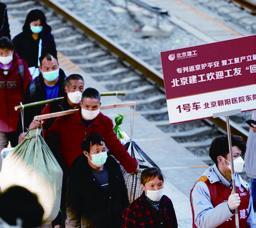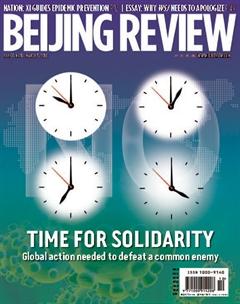FOR A BUMPER HARVEST


Welcoming Spring
Residents in Fuzhou, capital of Fujian Province in southeast China, visit a park on February 25.
Sea-Rail Service
The sea-rail transport service between the Port of NingboZhoushan and Yiwu, famed for the worlds leading small commodities market, has resumed daily operation. Both places are in Zhejiang Province, east China.
On February 14, 45 containers of solar accessories arrived at the port via the railway, ready to be shipped to overseas markets. With the service resumed, more commodities from Yiwu are expected to reach global markets including Europe, the U.S. and Southeast Asia.
The sea-rail transport management team has adopted “cloud working,” introducing online measures to ensure smooth operation.
Dubbed the worlds supermarket, Yiwu sells commodities to more than 550,000 overseas buyers in more than 210 countries and regions every year.
Fruit Train
A train loaded with fruit departed from the Dong Dang Railway Station in northern Viet Nam and arrived in Guangxi Zhuang Autonomous Region in south China on February 25.
Over 150 tons of dragon fruit on the fi rst China-Viet Nam fruit train will be shipped to cities across China after inspection and quarantine in a logistics center at the Pingxiang Port, which borders Viet Nam, China Railways Nanning bureau said.
The fruit import service at the Pingxiang Port has passed the inspection of the General Administration of Customs of China, opening a new channel for fruits produced in Southeast Asian countries to enter China.
According to the port, about two to three fruit trains are scheduled every week, and more fruit varieties are expected.
Scenic Safety
The Ministry of Culture and Tourism has asked scenic areas nationwide to continue implementing epidemic control measures and closely monitor tourist information, according to its guidelines issued on February 25.
The guidelines require realname ticketing, registration of tourists contact and travel information and big data-powered monitoring of tourist information as scenic attractions have gradually started reopening to the public.
Scenic spots in regions with a high risk of the epidemic, however, should remain closed for the time being, the guidelines read.
The spots that are to reopen should strictly control tourist volume and avoid crowds. Tourists should have their temperatures taken and wear masks before entering.
The ministry also requires scenic spots to monitor and report their employees health conditions and beef up hygiene and epidemic control at major venues.
Toy Fair
Robosen Robotics, a Chinese tech startup, made its debut at the annual Toy Fair in New York City with innovative gadgets for overseas consumers. It displayed a lineup of miniature robots called T9 at the exhibition.
Launched in China last year, the products have entered the U.S. market since 2020, Jerry Li, sales director of the Shenzhenbased company, told Xinhua News Agency.
The company hopes the products, with a combined focus on education and entertainment, would be well-received by international consumers including those in North America and Europe. The programmable robot can do highspeed, upright bipedal walking and convert from robot to vehicle form.
The 2020 Toy Fair New York, a four-day event that started on February 22, drew more than 1,000 exhibitors from around the world who showcased some 150,000 toys, games and youth entertainment products. Inaugurated in 1903, the exhibition is held in February every year as a tradeonly event.
Remote Service
Using a 5G-powered robot, doctors at a hospital in Zhejiang Province in east China conducted an ultrasound scan for a patient 700 km away in Wuhan, capital of Hubei Province in central China, the center of the novel coronavirus outbreak, on February 18.
Two doctors, Peng Chengzhong and Ye Ruizhong of Zhejiang Provincial Peoples Hospital, operated a robotic arm via a 5G network that performed the ultrasound scan for a patient in a temporary hospital in Wuhan.
It was not the fi rst time 5G remote ultrasound technology had been used to treat novel coronavirus patients.
Chinas fi rst remote ultrasonic medical certifi cate was issued when Peng conducted an ultrasound scan for a patient in a small city in Zhejiang on February 2.
The 5G smart medical innovation laboratory jointly established by the Zhejiang Provincial Peoples Hospital, telecommunication giant China Telecom and tech giant Huawei provided technical support for the two cases.

Returning to Work
Migrant workers from Chongqing in southwest China arrive in Beijing by a special train on February 26.
Work Index
The State Grid Zhejiang Electric Power Co. has launched a resumption power index using big data, which can refl ect the progress and trends of industries that have resumed work.
The index, based on companies previous and present power consumption, can show whether the operation of an enterprise has returned to a normal level as well as the number of enterprises that have resumed work.
It portrays the working situations after the resumption and can be used as a reference for local governments to formulate policies, according to the company.
Since February 10, some enterprises in the province have resumed work after a protracted holiday caused by the virus outbreak.
Measures Hailed
China has changed the course of the COVID-19 outbreak, Bruce Aylward, an epidemiologist who led an advance team from the World Health Organization (WHO), said on February 25. He said the rapidly escalating outbreak in China has plateaued and come down faster than previously expected.
Its the unanimous assessment of the 25-member team that conducted a nine-day fi eld study in Beijing, Guangdong, Sichuan and Hubei, he said. He added that he was impressed by the Chinese Governments pragmatic, systemic and innovative approach to control the outbreak.
China has taken a “differentiated approach” for different situations, which enabled a massive scale of epidemic control work without exhausting response, he said.
The WHO expert also praised the Chinese collective action, saying, “Its never easy to get the kind of passion, commitment, interest and individual sense of duty that help stop the virus.”
“Every person you talked to[in China] has a sense that theyre mobilized like in a war against the virus and they are organized,said Aylward, who was particularly impressed by thousands of healthcare workers volunteering to go to Wuhan.
He also referred to the repurposing of the government machinery. For example, the government formed a central leading group to handle the epidemic, and dispatched a central guiding team.

Voluntary Care
Workers at a restaurant prepare meals in Nanchang, Jiangxi Province in east China, on February 25. The restaurant has been providing free lunch and supper to community workers at the frontline of the coronavirus epidemic control since February 9.
Job Assistance
The local authorities should provide targeted employment assistance to prevent people from falling back into poverty due to the epidemic, the Ministry of Human Resources and Social Security and the State Council Leading Group Offi ce of Poverty Alleviation and Development said in a circular released on February 24.
Arrangements will be made so that migrant workers can return to work in a safe and orderly manner. Companies, poverty alleviation workshops and farmland irrigation projects should resume operation at the earliest in less affected regions.
Allowances will be given to key enterprises that give preference to qualifi ed poor workers in recruitment. Impoverished workers taking up temporary posts related to epidemic control will get subsidies.
The local authorities should guide the fi nancially disadvantaged laborers unable to leave the rural areas to prepare for spring plowing, sell farm produce on e-commerce platforms and engage in agricultural material transportation. Training and living subsidies will be provided to the impoverished undergoing online training while those out of work amid the epidemic will receive unemployment benefi ts.
The circular stressed that employment should be assisted in deeply impoverished regions by creating targeted job opportunities, enhancing export of organized labor services, increasing rural public welfare posts as well as providing fi nancial support.

Growth Plan
A worker picks mushrooms at a poverty alleviation industrial base in Chongqing, southwest China, on February 24. The base has resumed work while ensuring epidemic prevention and control measures.
Trade Promotion
A legal consultation platform for cross-border trade and investment has been built, the China Council for the Promotion of International Trade said on February 24.
Aimed at meeting the diversifi ed demands of enterprises, the platform collaborates with legal experts in various fi elds to address problems with better resources.
Since its recent establishment, it has processed nearly 4,000 consultations for enterprises. The problems mainly included contract performance, trade restrictions in some countries and diffi culties in attending overseas exhibitions.
Amid the epidemic, the council is helping enterprises with trade promotion, Chen Huaisheng, a council offi cial, said.
More measures will be taken to expand the service range of the platform and provide more legal support for enterprises.
Bond Futures
The China Securities Regulatory Commission (CSRC) said on February 21 that qualifi ed commercial banks and insurance institutions will be allowed to participate in treasury bond futures trading on the China Financial Futures Exchange.
The fi rst batch of pilot institutions will include the Industrial and Commercial Bank of China, the Agricultural Bank of China, the Bank of China, the China Construction Bank and the Bank of Communications.
The move aims to promote the healthy development of the treasury bond futures market, the announcement by the CSRC, the Ministry of Finance, the Peoples Bank of China and the China Banking and Insurance Regulatory Commission said.
It will meet the risk management needs of commercial banks and insurers, diversifying investment product types and improving bond asset management levels.
It will also help to enrich the market investor structure and promote stable and orderly development of the treasury bond futures market, the CSRC said.
Urban Projects
Beijing will push forward 300 urban projects in 2020, involving 252.3 billion yuan ($35.9 billion) in investment, the Beijing Municipal Commission of Development and Reform said on February 24.
They will consist of 100 infrastructure projects, 100 livelihood improvement projects and 100 hitech industrial projects, according to the commission.
Under the blueprint, this year the city will start or continue building 16 urban rail projects, including Line 22, a subway line that will extend to the northeastern suburban district of Pinggu.
The infrastructure package also includes 28 road projects, 11 waterway projects and six waste transportation and treatment projects.
The 100 livelihood improvement projects, with 130.9 billion yuan ($18.6 billion) in planned investment, will push for the completion of 90,000 subsidized houses this year. Also on the construction list are a number of new university campuses, hospitals, and old-age and other facilities.
Projects in the hi-tech category include experimental devices for extreme conditions, an integrated circuit production line and 5G facilities.
The city government said a special team will be set up to ensure the construction of the key projects, which will not be affected by the epidemic.

Back to Work
A worker moves materials for production at a workshop in Xingtai, Hebei Province in north China, on February 24. Hebei is assisting foreign-funded enterprises to deal with problems and key companies to resume work in an orderly manner.
Bank Blockchain
More banks are using the offi cial blockchain platform for trade and fi nance with increased efforts to research and promote this frontier technology, the Peoples Bank of China said.
As of December 17, 2019, a total of 38 banks participated in the platform, generating a combined business volume of 87 billion yuan($12.4 billion), according to an article published by an institution affi liated to the apex bank.
The Shenzhen-based blockchain platform, developed by the central bank and launched in September 2018, provides multi-stage accounts receivable fi nancing, a fast track for rediscounts and supervision over foreign trade payments.
Since 2014, the top bank has strengthened the study of blockchain and explored its application in transaction settlements as well as trade and fi nance, with its patents in the area ranking fi rst among all central banks in the world.
Blockchain was listed as a strategic frontier technology in a national industry plan in 2016. The Ministry of Industry and Information Technology released an action plan to encourage research and exploration in 2018.

Ensuring Supplies
A staff member checks an electrolyte production line at a new energy material company in Xian, Shaanxi Province in northwest China, on February 22. The company has accelerated production to ensure raw material supplies for its domestic and foreign clients.
Trade Livestreams
Livestreaming is expected to boost business in the worlds leading small commodities market in Zhejiang Province, east China.
Merchants at the Yiwu International Trade Market will be trading via livestreaming on ecommerce platform Taobao, the agency said on February 21.
Selling goods through Taobao livestreaming has become a trendy practice. At present, more than 3,000 merchants at the market have begun selling their commodities through livestreaming to customers from around the world.
Huang Xianping started selling products via online broadcasting in February. On messaging app WeChat, she wrote, “Livestreaming services provided by Taobao will defi nitely bring new opportunities to us merchants.”
Through the livestreaming, customers can see the products and save on travel expenses. For merchants, selling goods becomes more effi cient.
According to Taobao, since February, the number of new broadcasters has increased tenfold compared to the same period in January. More than 10,000 people are visiting the learning platform Taobao University daily to improve their livestreaming skills.
On February 25, Taobao opened a free online course to help merchants learn about online operations.

